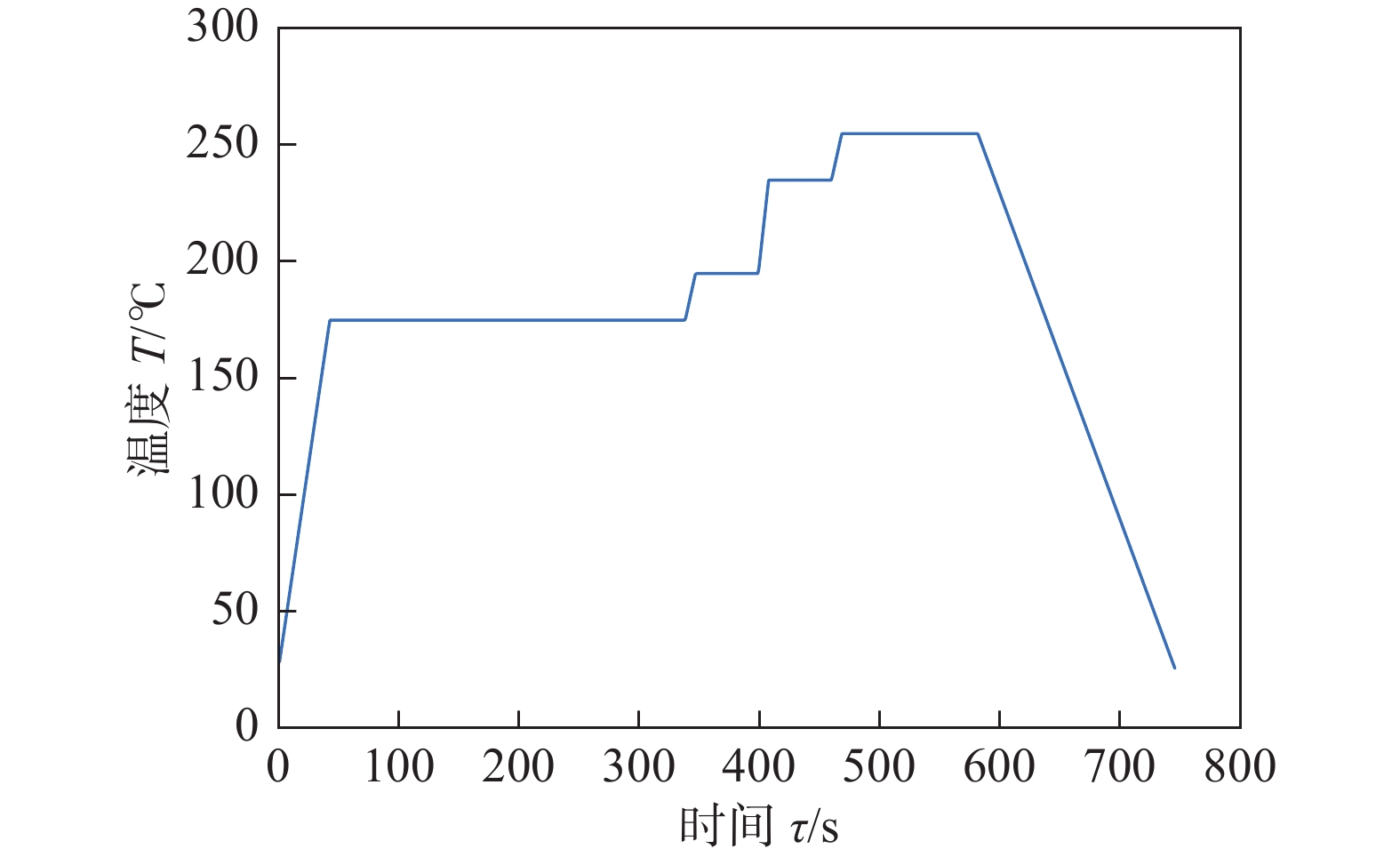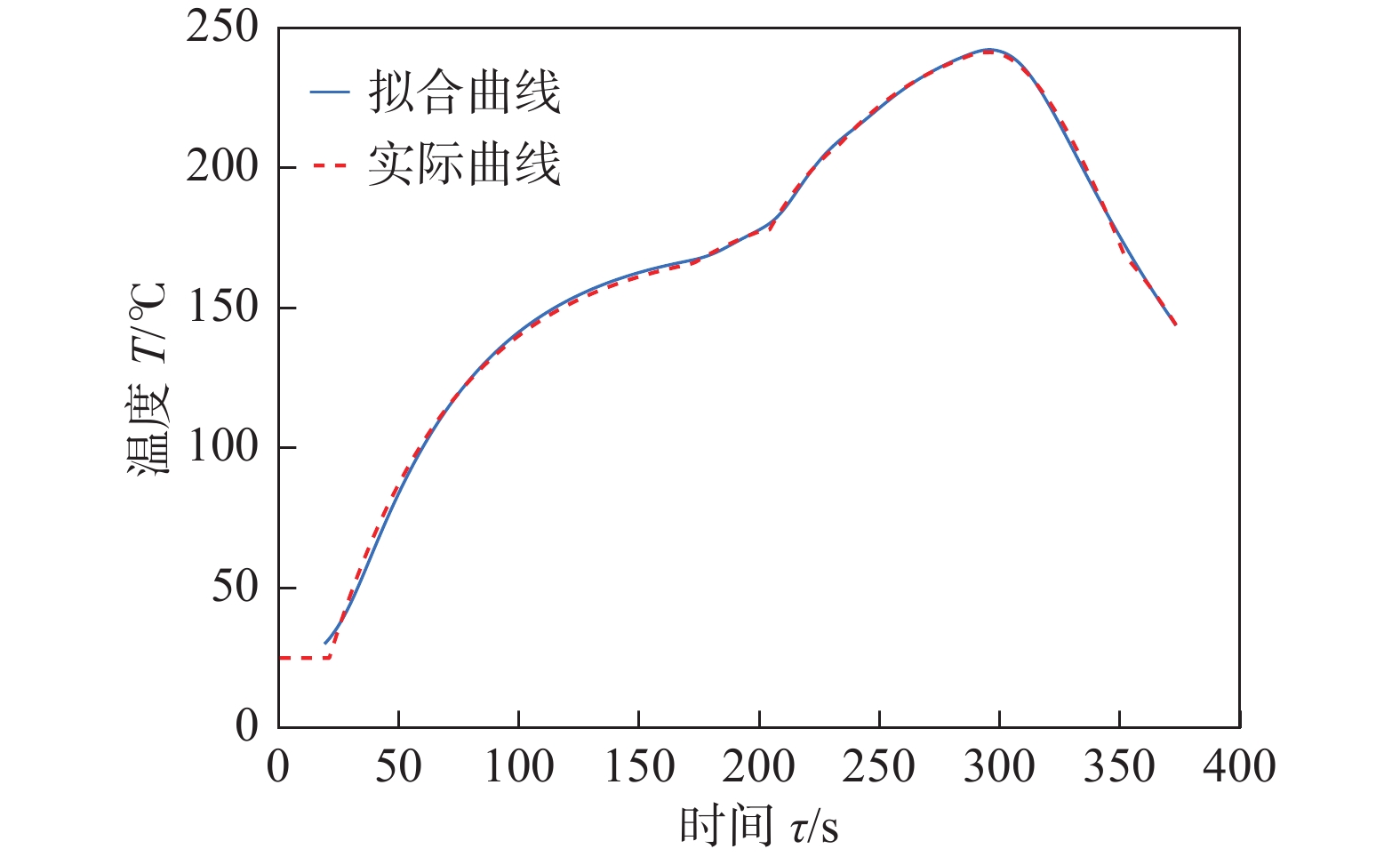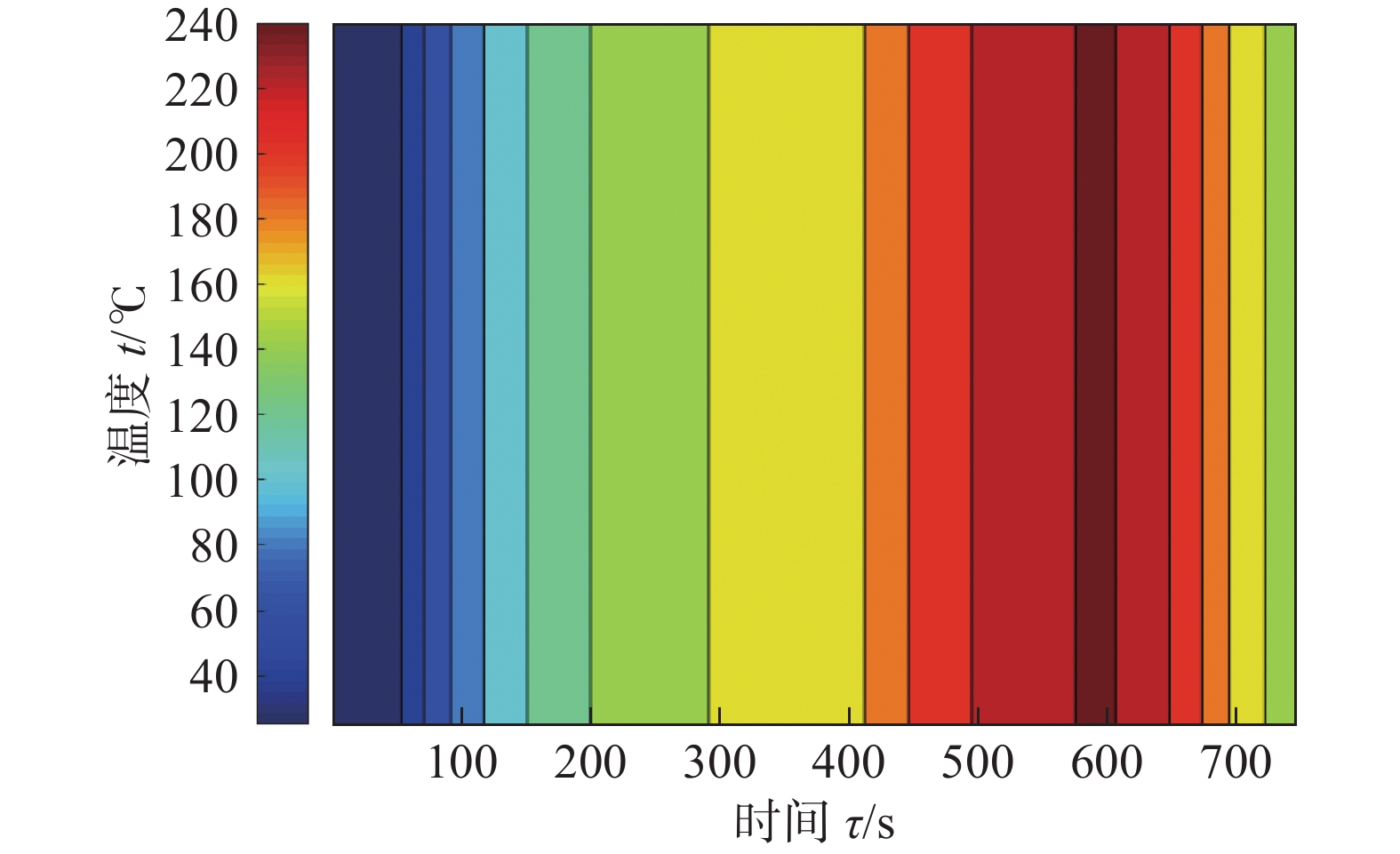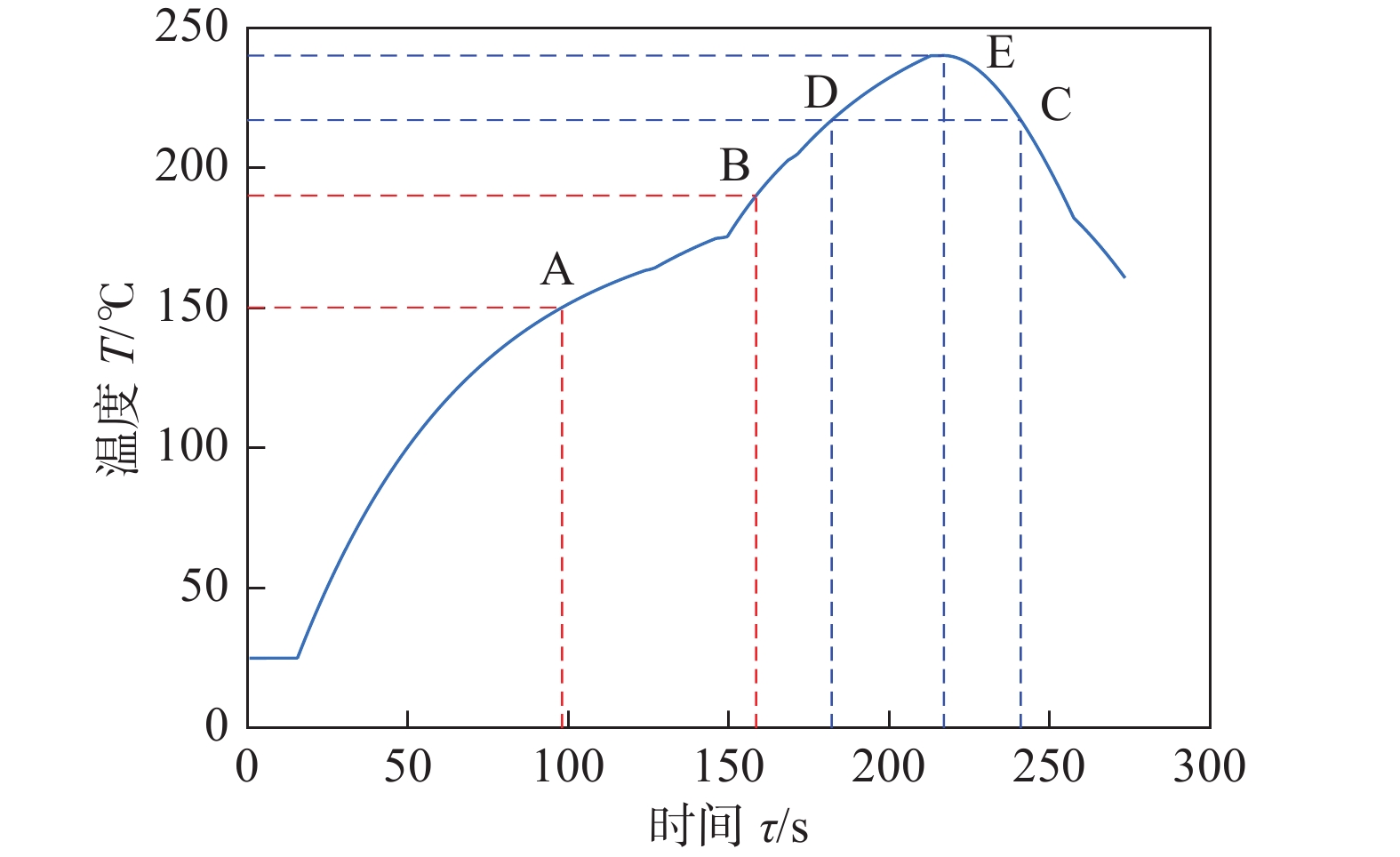Design of reflow oven furnace temperature based on quantum multi-objective optimization algorithm
-
摘要: 电路板焊接中心点的温度走势间接地反映了焊接质量,炉温曲线的优化设计对提高电路板焊接质量有着举足轻重的作用.文中运用傅里叶定律和集总参数法,建立反映电路板焊接中心温度变化的非稳态导热模型,并在满足制程界限和工艺要求的约束条件下,以传送带过炉速度最优和加热因子最小为目标,采用量子多目标粒子群算法(quantum multi-objective particle swarm optimization,QMOPSO)进行优化求解,获得了各温区的最优温度和电路板的最大过炉速度,并得到了最优炉温曲线.结果表明,优化后的电路板过炉速度为95.55 cm/min,接近速度上限,加热因子最小值为1753.04,炉温曲线整体呈现先上升后下降的趋势,峰值温度为240.01 ℃,接近温度制程界限下限,该结果为电路板等电子器件焊接工艺的实际工程应用和提高焊接质量提供参考.Abstract: The temperature trend of the welding center of circuit board indirectly reflects the welding quality. The optimization design of furnace temperature curve plays an important role in improving the welding quality of circuit board. In this paper, Fourier law and lumped parameter method were used to establish the unsteady heat conduction model reflecting the temperature change of the welding center of the circuit board. Under the constraints of meeting the process limits and technological requirements, the quantum multi-objective particle swarm optimization algorithm was used to optimize the solution with the goals of the optimal conveyor belt passing furnace speed and the minimum heating factor. The optimum temperature of each temperature region, the maximum passing speed of circuit board and the optimum temperature curve were obtained. The results show that the optimized circuit board passing through the furnace speed is 95.55 cm/min, which is close to the upper limit of the speed limit, and the minimum heating factor is 1 753.04. The furnace temperature curve shows a trend of rising first and then decreasing. The peak temperature is 240.01 ℃, which is close to the lower limit of the temperature process. The results provide strong guidance for practical engineering application and improvement of welding quality of electronic devices such as circuit boards.
-
0. 序言
钛合金具有优良的耐蚀性、较小的密度、较高的比强度及较好的韧性和焊接性[1-2],不锈钢具有良好的耐蚀性和较高的塑韧性[3-4],而钛合金/不锈钢复合结构由于同时具备两种合金的优点,在航空航天、化工、国防军事装备等领域得到了广泛的应用[5-6].然而,由于两种材料在晶格类型、原子半径、电负性等化学性能以及冶金兼容性方面的显著差异,钛合金/不锈钢异种材料焊接存在诸多挑战,其中最主要的难题是接头易生成脆性极高的Ti-Fe金属间化合物(intermetallic compound,IMC)[7-8],导致接头力学性能显著降低[9]. 因此,钛合金/不锈钢异种材料的优质、高效焊接问题受到研究人员的广泛关注,而过渡层金属的优化是改善焊接接头性能的有效途径之一[10-12].
目前国内外对于钛合金/不锈钢异种材料焊接用的过渡层金属方面进行了大量的研究. 研究表明,以纯Ag作为过渡层,虽然接头界面会有AgTi化合物相生成,但可获得力学性能较好的接头[13-14]. 然而,由于Ag成本的限制,Ag过渡层难以在实际工程中应用,目前主要集中在Cu,Ni等过渡层金属的研究,这是由于接头界面处形成的Cu-Ti相比Ti-Fe相具有更好的塑韧性. Zhang等人[15-16]研究了0.2和0.4 mm厚Cu箔对钛合金/不锈钢激光焊接头的影响,结果表明,添加两种厚度的Cu箔可获得抗拉强度分别为210和320 MPa的钛合金/不锈钢激光焊接头. Li等人[17]研究了添加纯Cu和Cu-Nb过渡层进行TC4钛合金/316L不锈钢激光焊接,结果表明,添加Cu-Nb过渡层接头的最高抗拉强度达到215 MPa. Wang等人[18]研究了添加0.5 mm铜片进行TA15钛合金/304不锈钢电子束焊接,获得了抗拉强度约为234 MPa的接头. 由此可见,虽然目前已有的添加Cu过渡层金属可提高钛合金/不锈钢焊接接头强度,但接头强度仍然较低,难以满足实际应用的更高强度要求.
激光焊具有能量密度高、焊接热输入低、焊接速度快、接头热影响区小、焊接应力和变形小以及光束能量及作用位置精确可控等优势[19],且不需要真空,生产中柔性高,极易实现自动化生产. 同时,激光焊接低的热输入有利于抑制接头界面IMC的形成,减小IMC层厚度,从而提高接头的力学性能[20]. 为此,采用力学性能优异的NAB取代纯Cu作为过渡层金属进行TC4钛合金/15-5PH不锈钢对接接头的激光焊接工艺探索,分析添加NAB过渡层对TC4钛合金/15-5PH不锈钢焊接接头微观组织和力学性能的影响,为钛/钢异种材料焊接接头力学性能的提升提供理论基础和新的研究思路.
1. 试验方法
选用的母材分别为3 mm厚的TC4钛合金板与3 mm厚的15-5PH不锈钢板,过渡层金属为NAB块体材料,厚度为2 mm. 采用X射线荧光光谱法测得3种材料的化学成分如表1所示.
表 1 材料的化学成分(质量分数,%)Table 1. Chemical compositions of materials材料 Mn Ni Al V Cr Cu Fe Ti TC4钛合金 — — 5.5 ~ 6.8 3.5 ~ 4.5 — — ≤0.30 88.4 ~ 90.7 NAB青铜 0.5 ~ 4.0 3.0 ~ 6.0 7.0 ~ 11.0 — — 77.5 ~ 82.0 2.0 ~ 6.0 — 15-5PH不锈钢 ≤1.0 4.7 ~ 5.7 — — 14 ~ 15 1.7 ~ 2.5 75.5 ~ 78.5 0.15 ~ 0.30 采用IPG公司生产的YLS-6000系光纤激光器进行双道激光焊接,焊接过程示意图如图1所示,第1道对TC4/NAB进行激光焊接,再以相同工艺参数立即对第2道NAB/15-5PH进行激光焊接,光斑均向NAB侧偏移. 为获得全熔透焊缝,优化的激光焊接工艺参数如表2所示.
表 2 优化的激光焊接工艺参数Table 2. Optimized laser welding process parameters激光功率
P/W焊接速度
v/(mm·min−1)离焦量
Δf/mm偏移量
d(mm)氩气流量
Q/(L·min−1)3500 2500 3 0.4 20 焊接完成后,采用线切割对接头进行切割取样,镶样经过研磨、抛光和腐蚀后制备金相试样.钛合金和不锈钢采用的腐蚀剂分别为Keller试剂和王水. 采用LEXT OLS4100型激光共聚焦显微镜和扫描电镜(scanning electron microscope,SEM)观察接头界面IMC组织形貌及分布;采用能谱仪(energy dispersive spectrometer,EDS)进行IMC成分分析;采用HVS-1000型显微硬度仪测试钛/钢接头显微硬度;采用液压万能材料试验机进行接头拉伸试验,试样依据GB/T 2651—2008《焊接接头拉伸试验方法》标准制样,拉伸性能结果取3个试样测试的平均值.
2. 试验结果与分析
2.1 钛合金/不锈钢异种材料接头的焊缝成形
添加NAB过渡层的TC4钛合金/15-5PH不锈钢异种材料激光焊接获得了良好冶金结合的全熔透接头,其横截面形貌如图2所示. 接头由钛合金侧热影响区(heat affected zone,HAZ)、钛侧界面及近钛合金侧过渡层区A、未熔化过渡层区B、近钢侧过渡层区C、钢侧界面及钢侧HAZ组成. 钛合金侧和不锈钢侧HAZ的宽度分别为0.21 mm和0.54 mm,钛合金侧HAZ宽度小于不锈钢侧. 过渡层焊缝中部产生一个尺寸较大的气孔,直径约为185.3 μm,未见裂纹等其它焊接缺陷.
2.2 钛合金/不锈钢接头力学性能
2.2.1 接头的硬度分布
图3为TC4钛合金/15-5PH不锈钢异种材料激光焊接头显微硬度分布曲线. 母材TC4钛合金和15-5PH不锈钢的平均硬度分别为347.6和405.7 HV. TC4钛合金及15-5PH不锈钢侧HAZ的硬度分别为390.5和 366.3 HV,中间过渡层焊缝铜合金区域硬度最低为211.9 HV. 由图3可见,接头TC4钛合金侧界面硬度最高,这是由于钛合金侧界面生成了脆硬的IMC. 然而,相对于TiFe2相的高硬度大于(1 000 HV),添加NAB过渡层钛合金侧界面IMC层硬度降低了约400 HV. 因此,添加NAB过渡层金属降低了钛合金侧界面区域的硬度,改善了钛合金侧界面IMC层的塑性.
2.2.2 接头的拉伸性能
TC4钛合金、15-5PH不锈钢、NAB过渡层及TC4钛合金/15-5PH不锈钢接头的拉伸测试结果如表3所示. TC4钛合金、15-5PH不锈钢、NAB过渡层金属的抗拉强度分别为1012,980,638 MPa,而添加NAB过渡层的钛合金/不锈钢激光焊接头的抗拉强度为290 MPa. 与已有的添加Cu过渡层钛合金/不锈钢焊接研究结果相比[15-18],添加NAB过渡层激光焊接头获得了较高的抗拉强度. 图4为TC4/NAB/15-5PH激光焊接头拉伸断口形貌. 接头拉伸试样均断裂在钛合金侧界面的IMC层,断裂位置如图4a所示. 由图4b可见,钛合金侧拉伸断口的表面光滑平坦,塑性变形很小.图4c为高倍SEM断口形貌,呈现河流花纹图样,为典型的脆性解理断裂,而这种脆性断裂与钛合金侧界面处形成的IMC层组织的形貌及物相组成密切相关.
表 3 激光焊接接头的拉伸性能Table 3. Tensile properties of laser welded joints材料 屈服强度ReL/MPa 抗拉强度Rm/MPa 断后伸长率
A(%)TC4钛合金 865 1012 ≥10.0 15-5PH不锈钢 785 980 ≥8.0 NAB青铜 268 638 15.0 TC4/15-5PH接头试样 — 290 2.0 2.3 钛合金/不锈钢接头不同区域的微观组织
图5为TC4钛合金/15-5PH不锈钢接头焊缝组织形貌. 靠近钛合金侧界面的NAB过渡层熔化结晶形成的焊缝(图5a)呈现了细小的等轴晶,弥散分布着球形的IMC颗粒,对该IMC颗粒进行点扫描分析,该IMC颗粒原子组成为27.52%Ti,26.50%Fe,22.06%Ni,23.92%Cu,因此,推测此球形颗粒可能为NiTi或TiFe相. 过渡层中部区域组织(图5b)有粗大的等轴晶组成,晶界上分布着细小的IMC颗粒,证实过渡层NAB金属存在未熔的区域,未熔区域的存在对钛合金与不锈钢母材可以起到屏障作用,有利于抑制Fe,Ti在接头界面中的相互扩散[21],从而抑制Fe-Ti IMC的生成. 图5c为靠近不锈钢侧过渡层NAB金属熔化凝固形成的焊缝区,显示了网状分布的等轴树枝晶组织,与钛合金侧焊缝组织明显不同.
图6为TC4钛合金/15-5PH不锈钢异种接头不锈钢侧界面的组织形貌. 从图6可见,在不锈钢侧界面处无明显IMC生成,这是因为Cu和Fe能够相互溶解形成连续的固溶体界面. 在界面附近NAB过渡层金属中形成了较多的直径为0.5 ~ 1.0 μm的球形气孔,这些微气孔的存在可能会对接头拉伸断裂行为有一定的影响.
图7和图8为激光焊接TC4钛合金/15-5PH不锈钢异种材料钛合金侧界面的组织形貌. 由图7可见,TC4钛合金侧界面处形成了复杂的IMC层,依据IMC组织的晶粒形态分为Ⅰ,Ⅱ,Ⅲ 3个区域,其相应的高倍SEM形貌如图8所示.
采用EDS能谱对IMC进了点扫描分析,测得各合金元素的含量如表4所示. 图8显示的IMC组织厚度约为67.50 μm,靠近TC4钛合金侧的Ⅰ区IMC组织密集分布,其中标记为1 ~ 3相富集Cu,Ti元素,由原子含量计算推测形成的IMC为CuTi2和CuTi相. 临近I区的Ⅱ区IMC组织中黑色相4和灰色相5,6的晶粒明显粗大,富集Ni,Ti元素,根据原子含量计算4相可能为CuTi,NiTi2,经Gibbs free energy公式计算[22],G(NiTi2) = −49 120 + 17.21T,G(CuTi) = −17 534 + 3.37T;T = 1 023 K时,G(NiTi2)(−31.5 J/mol) < G(CuTi)(−14.1 J/mol),因此4相为NiTi2;5相为NiTi相;6相可能为FeTi2和NiTi2,经计算G(FeTi2) = −15 219 − 2.29T,T = 1 023 K时,G(FeTi2) (−17.6 J/mol) > G(NiTi2),因此6相为NiTi2. 由此可知,Ⅱ区IMC组织为NiTi和NiTi2相. 靠近不锈钢侧Ⅲ区IMC中黑色相7的晶粒尺寸显著细化,由原子含量计算7和9相可能为NiTi2,FeTi2相,G(FeTi2) > G(NiTi2),因此7和9相主要为NiTi2相,8相为Cu基固溶体,因此该层主要为少量的NiTi2相弥散在铜基体中形成. 因此,Ⅲ区IMC组织主要由CuTi2,CuTi,NiTi和NiTi2组成. 可见,添加NAB中间层接头钛合金侧界面形成了大量脆性相对较低的Cu-Ti,Ni-Ti相,Ti-Fe 相数量减少. 因此,添加NAB中间层有效地抑制了Fe和Ti在钛合金侧界面的相互扩散,界面处形成了大量塑性相对较好的Cu-Ti,Ni-Ti相,有利于改善接头的抗拉强度.
表 4 TC4侧界面IMC组织的EDS分析(原子分数,%)Table 4. EDS analysis of IMC structure of TC4 side interface区域 Ti V Cr Fe Ni Cu 可能的物相 1 57.47 1.29 1.01 1.19 1.55 37.50 CuTi2 2 40.71 1.07 0.17 2.47 3.48 52.10 CuTi 3 25.18 0.98 0.06 1.63 1.69 70.45 CuTi 4 34.15 0 0.12 12.26 14.54 38.93 CuTi,NiTi2 5 16.30 0.11 0.10 3.63 12.56 67.30 NiTi 6 4.32 0 0 2.34 2.32 91.02 FeTi2,NiTi2 7 33.69 0.25 0.24 20.56 20.50 24.76 NiTi2,FeTi2 8 6.10 0.06 0.05 3.47 3.66 86.65 Cu 基固溶体 9 33.01 0 0.14 16.35 15.68 34.83 NiTi2,FeTi2 3. 结论
(1) 添加NAB过渡层钛合金/不锈钢异种材料激光焊接可获得成形优良的全熔透钛/钢异种接头. 接头拉伸断裂于钛合金侧界面IMC层,接头的抗拉强度可达290 MPa,断后伸长率为2.0%.
(2) 接头钛合金侧界面IMC层硬度最高为547.8 HV,相对脆性高Ti-Fe相的硬度降低了400 HV以上.
(3) 接头钛合金侧界面形成的IMC层的宽度约为67.5 μm,主要由CuTi2,CuTi,NiTi,NiTi2相及少量的FeTi2相组成,脆性相对较低的Cu-Ti,Ni-Ti相数量增加,接头不锈钢侧界面未形成IMC.
-
表 1 回焊炉各温区长度和温度
Table 1 Length and temperature of each temperature zone in rewelding furnace
区域 长度l/cm 温度T/℃ 炉前 25 25 1 ~ 5 172.5 175 6 30.5 195 7 30.5 235 8 ~ 9 66 255 10 ~ 11 66 25 炉后 25 25 间隙 5 — 表 2 传送带速度需满足的制程界限
Table 2 Process limits for conveyor speed
炉温曲线峰值温度 T/℃ 焊接中心升温过程中位于
[150 ℃, 190 ℃]温度区间的时间 τt/s焊接中心温度变化速率(dt/di)/(℃·s−1) 焊接中心温度位于[217 ℃,tmax]温度
区间的时间 τt/s240 $\leqslant $ tmax$\leqslant $ 250$\dfrac{\text{d}t}{\text{d}\tau } > 0$
且60 < τt∈[150 ℃,190 ℃]$ < 120 $ −3 $ < \dfrac{\text{d}t}{\text{d}\tau } < $ 340 $\leqslant $ ${\tau _{t \in [217\;{\text{℃} },\;{ { {t_{\max } }]} }} }$ $\leqslant $ 90表 3 3种不同优化情况结果
Table 3 Results of three different optimization conditions
目标参数 过炉速度v/(cm·min−1) 加热因子
Scover最小加热因子min (Scover) 94.05 1 027.80 最大过炉速度max (v ) 95.626 2 2 931.56 最小加热因子min (Scover)和
最大过炉速度max (v )95.55 1 753.04 表 4 优化后炉温曲线内特殊点坐标值
Table 4 Coordinate values of special points in the furnace temperature curve after optimization
点 坐标 点 坐标 A (98.50,150.11) D (183.00,216.97) B (159.00,190.02) E (219.00,240.01) C (242.50,217.36) 表 5 优化后获得的最优温区温度值
Table 5 Optimal temperature value of temperature zone obtained after optimization
温区 优化后温度T0/℃ 温区 优化后温度T0/℃ 1~5 184.34 8~9 264.81 6 199.35 10~11 25 7 239.07 -
[1] Luo X D, Wang Z S, Deng W H. Optimization model design for temperature curve of reflow furnace[J]. Journal of Physics: Conference Series, 2021, 1802(2): 022020.
[2] Harrison M R, Vincent J H, Steen H A H. Lead-free reflow soldering for electronics assembly[J]. Soldering & Surface Mount Technology, 2001, 13(3): 21 − 38.
[3] 陈恒宇,丁唯一,殷寰宇,等.基于量子遗传算法的回焊炉参数设定[J].重庆理工大学学报(自然科学),2021,35(9):248-255. Chen Hengyu, Ding weiyi, Yin Huanyu, et al. Back-welding furnace parameter setting based on the quantum genetic algorithm [J]. Journal of Chongqing University of Technology (Natural Science), 2021,35 (9): 248-255.
[4] 郑风景. 基于六西格玛方法的SMT回流焊产品质量控制研究[D]. 天津: 天津科技大学, 2014. Zheng Fengjing. Research on quality control of SMT reflow soldering process based on the six sigma approach[D]. Tianjin: Tianjin University of Science & Technology, 2014.
[5] 徐宗煌,徐剑莆,李世龙,等. 回焊炉电路板焊接炉温曲线优化模型[J]. 沈阳大学学报(自然科学版), 2021,33(3):279-286. Xu Zonghuang, Xu Jianpu, Li Shilong, et al. Optimization model of welding furnace temperature curve of back-welding furnace circuit board [J]. Journal of Shenyang University (Natural Science Edition), 2021,33 (3): 279-286.
[6] 焦进莉. 六西格玛方法在提升SMT回流焊过程质量中的应用研究[D]. 上海: 上海交通大学, 2011. Jiao Jinli. The application study of six sigma approach on quality improvement of SMT reflow process. [D]. Shanghai: Shanghai Jiaotong University, 2011.
[7] 李楠, 王晓杰, 杜咏昊. 最优炉温曲线与确定其工艺参数问题[J]. 电子测试, 2021(1): 48 − 50. doi: 10.3969/j.issn.1000-8519.2021.01.017 Li Nan, Wang Xiaojie, Du Yonghao. Optimal furnace temperature curve and determination of process parameters[J]. Electronic Test, 2021(1): 48 − 50. doi: 10.3969/j.issn.1000-8519.2021.01.017
[8] 王明泉, 周心如, 李博文. 基于热力学原理的炉温曲线调控模型[J]. 科学技术创新, 2021(1): 1 − 3. doi: 10.3969/j.issn.1673-1328.2021.01.002 Wang Mingquan, Zhou Xinru, Li Bowen. Control model of furnace temperature curve based on thermodynamic principle[J]. Scientific and Technological Innovation, 2021(1): 1 − 3. doi: 10.3969/j.issn.1673-1328.2021.01.002
[9] 方灏航. 基于传热学的炉温曲线研究[J]. 现代信息科技, 2020, 4(20): 18 − 22. Fang Haohang. Furnace temperature curve research based on heat transfer[J]. Modern Information Technology, 2020, 4(20): 18 − 22.
[10] Lei Q Y, Zhang Z Y, Zhuo S Y, et al. Research on furnace temperature curve based on heat convection and heat radiation[J]. E3S Web of Conferences, 2021, 233(9): 04004.
[11] Wealer B, Bauer S, Hirschhausen C V, et al. Investing into third generation nuclear power plants—Review of recent trends and analysis of future investments using Monte Carlo Simulation[J]. Renewable and Sustainable Energy Reviews, 2021, 143: 110836.
[12] 祝胜光, 杨安全. 小型回流焊炉温度PID控制算法研究[J]. 机械工程与自动化, 2012(1): 138 − 140. doi: 10.3969/j.issn.1672-6413.2012.01.054 Zhu Shengguang, Yang Anquan. Study on the temperature PID control algorithm of small reflux welding furnace[J]. Mechanical Engineering & Automation, 2012(1): 138 − 140. doi: 10.3969/j.issn.1672-6413.2012.01.054
[13] Sun J, Wu X J, Palade V, et al. Convergence analysis and improvements of quantum-behaved particle swarm optimization[J]. Information Sciences, 2012, 193: 81 − 103.
[14] Wang F, Zhang H, Zhou A M. A particle swarm optimization algorithm for mixed-variable optimization problems[J]. Swarm and Evolutionary Computation, 2021, 60: 100808. doi: 10.1016/j.swevo.2020.100808
[15] 冯茜, 李擎, 全威,等. 多目标粒子群优化算法研究综述[J]. 工程科学学报, 2021, 43(6): 745-753. Feng Qian, Li Qing, Quan Wei, et al. Overview of multiobjective particle swarm optimization algorithm[J]. Chinese Journal of Engineering, 2021, 43(6): 745-753.
[16] Zhang D G, Wang J X, Fan H R, et al. New method of traffic flow forecasting based on quantum particle swarm optimization strategy for intelligent transportation system[J]. International Journal of Communication Systems, 2020, 34(1): e4647.
[17] 邱幸运. 基于量子粒子群算法的工程项目多目标优化研究[D]. 邯郸: 河北工程大学, 2019. Qiu Xingyun. Multi-objective optimization of engineering projects based on quantum-behaved particle swarm optimization [D]. Handan: Hebei University of Engineering, 2019.
[18] Gao J G, Wu Y P, Ding H. Optimization of a reflow soldering process based on the heating factor[J]. Soldering & Surface Mount Technology, 2007, 19(1): 28 − 33.
[19] Campo A, Arici M. Lucid characterization of unsteady heat conduction in large, square crossbars and cubes subject to uniform surface heat flux by way of “quasi-steady” Helmholtz equations[J]. Thermal Science and Engineering Progress, 2020, 20: 100724. doi: 10.1016/j.tsep.2020.100724
[20] Yang Z. Investigation on the thermal problems of wet clutches for the tracked DCT vehicle during the launching process[J]. IOP Conference Series Materials Science and Engineering, 2020, 892: 012046. doi: 10.1088/1757-899X/892/1/012046
[21] 郭安柱, 马永志. 空调房数学建模与仿真[J]. 科学技术创新, 2020(12): 120 − 122. Guo Anzhu, Ma Yongzhi. Mathematical modeling and simulation of air-conditioned room[J]. Scientific and Technological Innovation, 2020(12): 120 − 122.
[22] Gao J G, Wu Y P, Ding H, et al. Thermal profiling: a reflow process based on the heating factor[J]. Soldering & Surface Mount Technology, 2008, 20(4): 20 − 27.
[23] 李岩, 赵立博, 张伟, 等. 对回流焊炉温度设定的分析与优化[J]. 船电技术, 2010, 30(7): 44 − 46. doi: 10.3969/j.issn.1003-4862.2010.07.012 Li Yan, Zhao Libo, Zhang Wei, et al. Analysis and optimization on the temperature settings of reflow soldering furnace[J]. Marine Electric & Electronic Engineering, 2010, 30(7): 44 − 46. doi: 10.3969/j.issn.1003-4862.2010.07.012
[24] 高金刚. 表面贴装工艺生产线上回流焊曲线的优化与控制[D]. 上海: 上海交通大学, 2007. Gao Jingang. Optimization and control of reflow soldering profile in SMT line[D]. Shanghai: Shanghai Jiaotong University, 2007.
[25] Zhao Y X, Song X T, Wang F, et al. Multiobjective optimal dispatch of microgrid based on analytic hierarchy process and quantum particle swarm optimization[J]. Global Energy Interconnection, 2020, 3(6): 562 − 570. doi: 10.1016/j.gloei.2021.01.008
[26] Wang R J. Multi-objective configuration optimization method for a diesel-based hybrid energy system[J]. Energy Reports, 2020, 6: 2146 − 2152. doi: 10.1016/j.egyr.2020.08.004
[27] Hou H, Liu P, Xiao Z F, et al. Capacity configuration optimization of standalone multi-energy hub considering electricity, heat and hydrogen uncertainty[J]. Energy Conversion and Economics, 2021, 2(3): 122 − 132.
-
期刊类型引用(9)
1. 夏忠虎,张友昭,任延杰,李相伟,张书彦. 一种新型增材制造FeCoNi中熵合金的时效硬化行为. 焊接. 2024(02): 36-42 .  百度学术
百度学术
2. 田宪华,杨晓东,刘亚,王磊. 激光熔覆涂层材料的研究现状. 热加工工艺. 2024(06): 1-5+9 .  百度学术
百度学术
3. 张欣,蒋淑英,杨昊炎,张恒玮,胡伟伟. CoCrMnNiMo_x高熵合金涂层的组织和耐磨耐蚀性研究. 材料保护. 2023(06): 106-114+122 .  百度学术
百度学术
4. 卢煜,李春燕,田霖,翟建树,寇生中. 高熵合金的性能研究进展. 稀有金属. 2022(10): 1352-1364 .  百度学术
百度学术
5. 鲁铭洋,张欣,蒋淑英,冯涛,王彦芳. 激光熔覆CoCrFeMnNiMo_x高熵合金的组织和耐蚀性研究. 精密成形工程. 2022(12): 50-57 .  百度学术
百度学术
6. 冯伟,邹力维,韩宇,陈波,徐锴. 堆焊工艺对镍基276带极堆焊晶间腐蚀的影响规律. 压力容器. 2021(03): 25-30 .  百度学术
百度学术
7. 李晓鹏,周龙,贺涛江,程锌谋,王庆梅,张英哲. 氩弧焊接方法制备FeCoNiCrAl高熵合金焊接接头的组织和力学性能研究. 贵州农机化. 2021(04): 27-30 .  百度学术
百度学术
8. 黄晋培,章奇,李忠文,于治水. T10钢表面FeMoCoNiCrTi_x高熵合金熔覆层组织及性能. 有色金属科学与工程. 2020(03): 39-43+120 .  百度学术
百度学术
9. 郝文俊,孙荣禄,牛伟,谭金花,李小龙. 合金元素影响高熵合金涂层组织及力学性能综述. 材料导报. 2020(S2): 1330-1333 .  百度学术
百度学术
其他类型引用(10)



 下载:
下载:




















